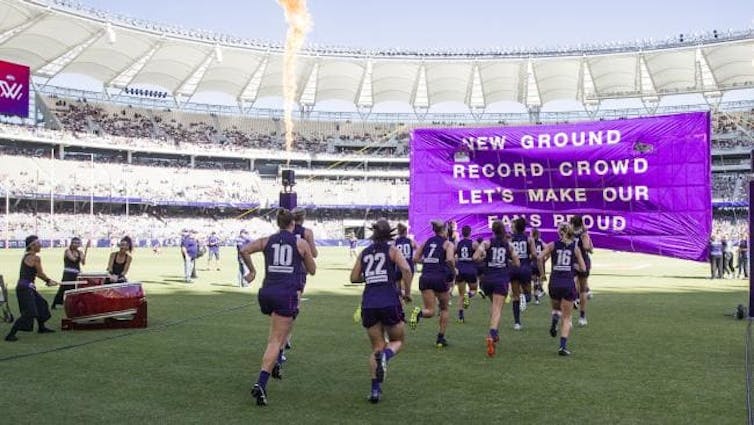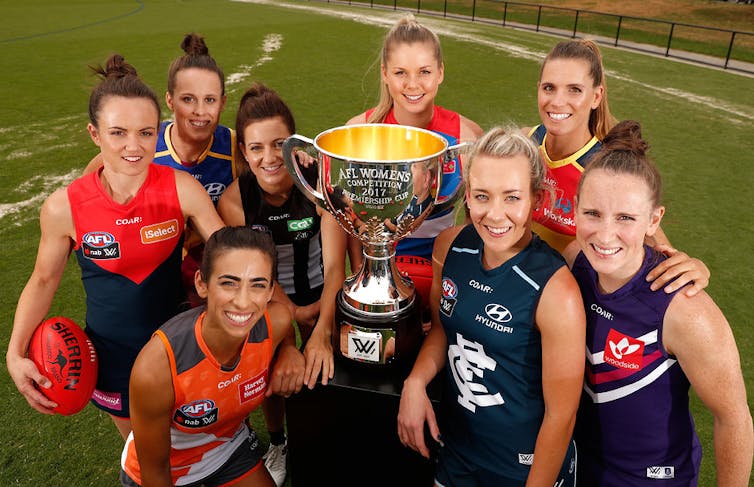The AFLW found instant success, but challenges remain for its long-term sustainability
- Written by Keith D. Parry, Senior Lecturer in Sport Management, University of Winchester
This has been a momentous year for women’s sport in Australia. For the first time, the country’s major sporting leagues had both male and female competitions following the introduction of the NRL Women’s Premiership – a tournament that builds on the success of the first-ever Women’s State of Origin competition.
Since 2015, new elite women’s competitions have been introduced in Australian football (AFLW), cricket (Women’s Big Bash League) and Rugby League, while the National Netball League emerged as a replacement to the ANZ Championship. The top-division women’s football competition, the W-League, has also grown in visibility, with a new deal to televise all of its matches.
A recent study highlighted increasing numbers of women’s sport fans, as well. It found that 84% of sport fans in Australia and seven other countries were interested in women’s sport. Among men, 51% said they were engaged in women’s sport.
Read more: The AFL's gender diversity policy remains an apprehensive work in progress
While this is all good news for women’s sport, challenges remain. And with the AFLW about to enter its third season, it is a critical time for this league in particular.
The league’s success has clearly been seen as a threat to some. Former AFL player Mick Malthouse sparked outrage – and prompted AFLW star Moana Hope to storm out of a Grand Final luncheon – when he suggested the AFL was a “man’s game”. He went on later to say:
Let’s get the game into such a manner that it doesn’t expose the girls to the injuries that some of the men are copping, because we are built differently.
Lingering stereotypes and misogyny are one thing. But the AFLW also needs to address critical funding and visibility issues in order to ensure its long-term viability, including tackling big questions over whether to charge fans for tickets and how to pay players a living wage.
Maintaining fan interest
Attendance figures for the AFLW have been higher than was initially expected. When the league launched last year, the first four games drew more than 50,000 fans. A crowd of nearly 41,975 also turned out for a match between Fremantle and Collingwood earlier this year, setting a record for the largest stand-alone women’s sporting event in Australian history.
So far, the vast majority of AFLW games have been free to attend (except when scheduled before a men’s game in a double-header). Significantly, the fans at the Fremantle-Collingwood match paid a A$2 entry fee. Yet, the challenge of making the AFLW profitable in the long run remains.
 The Fremantle-Collingwood AFLW match broke a record for fan attendance.
AAP Image/Tony McDonough
The Fremantle-Collingwood AFLW match broke a record for fan attendance.
AAP Image/Tony McDonough
The AFL has considered charging for tickets to all games – a major step that would certainly ensure the league’s sustainability. First, this would generate revenue to allow for greater wages for the players. It also places a value proposition on the sport and gives the league a greater degree of credibility.
The WBBL has taken this approach this season, charging fans A$10 to attend games in Sydney. Sydney Sixers general manger Jodie Hawkins said of the move:
The decision to ticket the WBBL is in line with the value we believe the elite matches deliver and our match-day experiences will reflect that.
Sponsorships and TV deals
With 41% of Australians indicating they are interested in women’s footy, according to a recent study, there is clearly a demand for the sport. But it is still difficult to turn this general fan interest into a financial commitment through purchasing both tickets and merchandise. This may be even more difficult with men.
Investment in marketing and TV coverage is key to changing this. Sponsors have been quick to support the AFLW, with many citing the image of the sport as a good fit for their brands. The lack of off-field scandals, compared to male players, is also appealing to sponsors.
Read more: Mark! Kick! Tackle! The reality of fast-tracking women into elite AFL
A number of new, high-profile sponsors came on board after the first season’s success. Existing AFL sponsors have also been keen to include sponsorship of the AFLW in new deals. However, the growth of all the new women’s leagues – from rugby league to cricket – means that competition for sponsors is as fierce as the action on the field.
Sponsorship deals are aided by television coverage of the sport and the AFLW has been a ratings success. But there’s a caveat: the initial two-year deal with Channel Seven and Foxtel saw the rights given away for free. The current AFLW broadcasting deal has been described as a “bargain-basement broadcast agreement”, but a renegotiated deal was delayed while the AFL decided on the structure of the 2019 season.
Increasing the visibility of women on the sidelines of AFLW matches is also important for the sport to grow.
Kelli Underwood is delivering excellent commentary on games – a much-needed shift in the culture of masculinity that has long dominated sports broadcasting. Underwood is also one of the hosts of a new AFL show, On The Mark, that is primarily fronted by women. Meanwhile, ABC Grandstand’s 50-50 gender split for its radio commentary teams has brought a rise in its ratings.
Having women represented on the commercial channels reaffirms that sport is something they can and do have valid opinions about. Yet, while inroads are being made, opportunities covering AFL remain few and far between for women overall.
 The teams in the inaugural AFLW season.
AFL
The teams in the inaugural AFLW season.
AFL
Paying a living wage
The AFLW is set to expand the number of teams in 2019 and then again the following year. Yet, controversially, the number of games each team will play this season will remain the same.
This is problematic in terms of offering players a decent wage. The AFLW season is short. Players were only contracted for 24 weeks in 2018. Given that the highest basic AFLW salary was just A$20,000 last season, it is unsurprising that many players are not full-time professionals.
Read more: Growth of women’s football has been a 100-year revolution – it didn't happen overnight
AFLW players struggle to make a living from the sport. Many are forced to compete in a variety of leagues around the world during their off-seasons, or in a number of different sports. This situation needs to change so that women’s sport is valued and women can focus on being full-time, professional athletes.
Whether women’s sport will continue to grow in a highly competitive landscape is uncertain. But growing the commercial interests in the game and increasing its visibility will no doubt ensure the league’s future is sustainable and profitable. It is now time for fans and administrators to put their money where their mouths are and support women’s sport in meaningful ways.
Authors: Keith D. Parry, Senior Lecturer in Sport Management, University of Winchester





